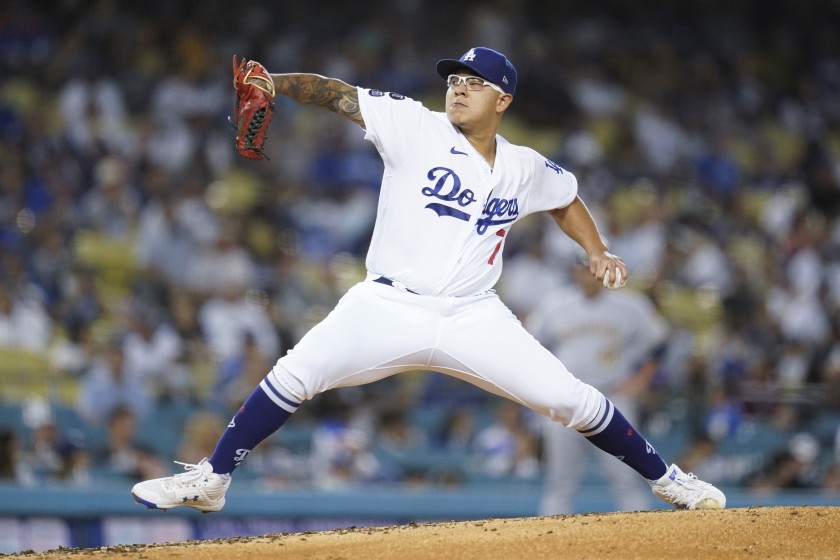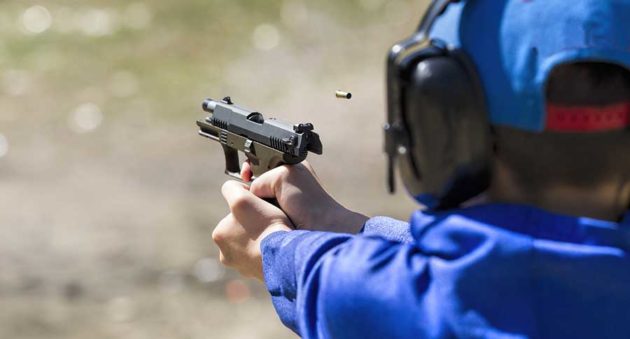At 108 Performance, we have one specific kid in our program that stands out among the rest. This kid isn’t a big leaguer, college player, to even a starter on his high school varsity team. He’s only six years old. His name is Kellen.
Now Kellen doesn’t really stand out physically. He’s about what you would expect from a six year old. When he inquired about training, we had obvious hesitations. Is he going to mix well with the guys? Will he be too shy? Will he work? Is he old enough and physical enough to handle the shop environment where college, pro, and high school kids can be training at the same exact time?
Pretty much all of those questions were answered when we watched him swing a bat:
Yeah, not bad for a six year old.
Here’s the thing: When Kellen is in the shop with us, we don’t really tell him much anything. We don’t tell him where to hold his bat, where his back elbow should be, or what his back foot should do. The only thing we do is give him permission to do damage: Swing hard, hit heavy stuff, and have fun.
Kellen doesn’t just have a pretty good swing. He has a swing most of our older kids wish they had. His biggest challenge going forward won’t be finding barrels.
It’ll be making sure he doesn’t get coached out of the things he already knows how to do really well.
Question: If you were to guess which population of baseball players most closely resembles big league athletes from a biomechanics standpoint, which do you think it is?
- Elite college players
- Elite high school players
- Elite, uncoached youth players
If you guessed the third option – elite, uncoached youth players – you are correct.
When we look at kids like Kellen, we see the same exact patterns from the best hitters in the game. They find the most amount of stability, stop their hips the fastest, and pound for pound get more energy transmitted into he strike than any other players that aren’t big leaguers. Rotation isn’t a foreign concept. It’s intuitive. From birth, we all know how to turn around our spine. Our first three landmark movements – rolling, crawling, walking – are all examples of reciprocal movement. So is rotation.
The problem becomes when we coach kids out of these natural patterns.
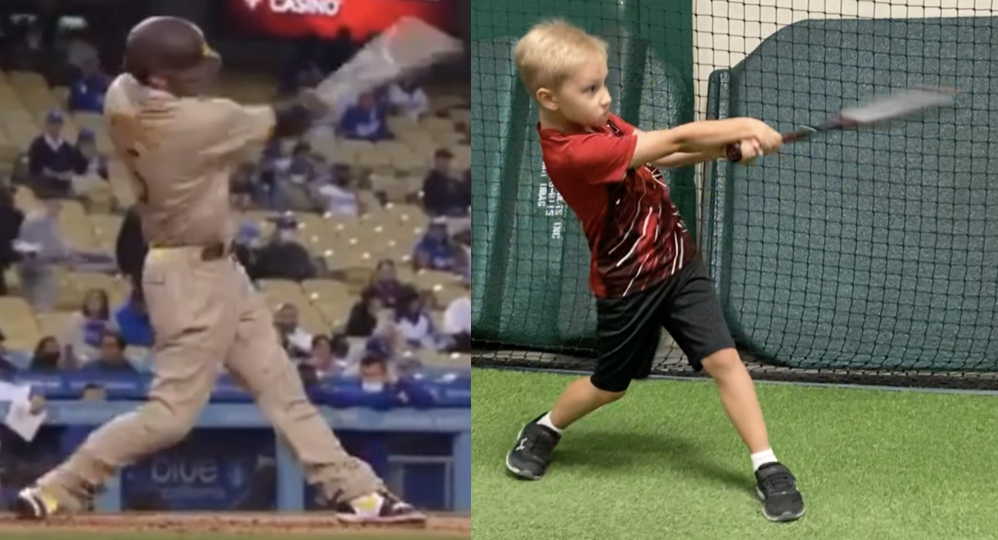
We had a young kid come in for an evaluation the other day. He’s currently 11 years old and plays at a pretty high level. He started warming up by taking swings off the tee. There was a lot of good stuff going on in his swing. However, there was a slight disconnect.
It made a lot more sense when we saw his routine between pitches:
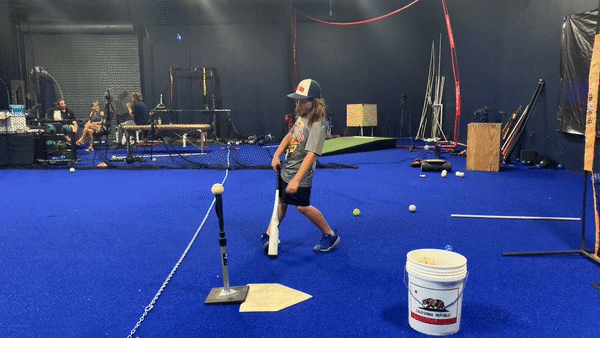
There was a reason why the word “uncoached” was included in the third option above. The reason why this kid was missing baseballs wasn’t because he intuitively decided to start spinning his back foot into impact. It’s because a coach told him it was important. He was given information that works against what our body naturally knows how to do. My good friend Lantz Wheeler says it best: “Most mechanical flaws are man made.”
When you work with young kids, you’re not fighting against years where they’ve patterned a poor blueprint for how to move. You’re getting them as raw as they come. They don’t have a hardwired Central Nervous System (CNS). They’re not married to a bad drill routine their 10U travel coach told them to do. They just do what their body naturally knows how to do really well: Rotate and deliver a strike.
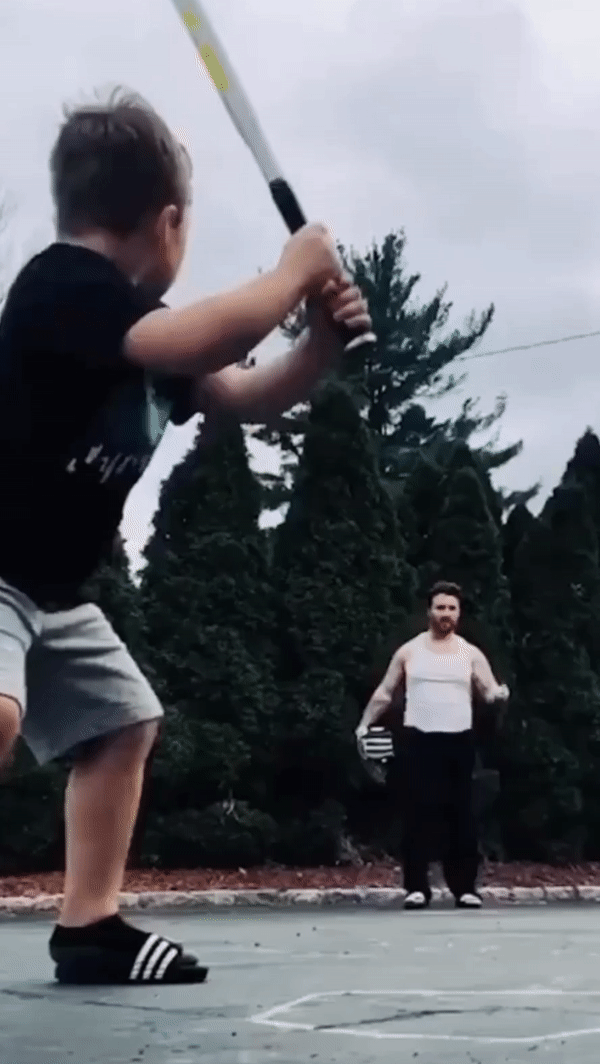
While their size and physicality looks like a disadvantage from the outside, it actually creates a really powerful advantage. They can’t rely on muscles or independent segments to generate force. They have to use their entire body. They’re recruiting the entire system – not just individual parts of the system. This is efficiency. If we want to do more with less, we have to learn how to use more. You can’t disperse the work if you don’t have enough helping hands.
So if kids already do plenty well without our help, how do we actually help them in a way that continues to harness what God gave them?
That’s where it gets fun.
Let’s go back to Kellen’s swing from above. This swing was captured during one of our training sessions this summer. In this round, Kellen wasn’t just swinging. He was competing in a game. On the far end of the cage, Kellen’s opponent was bouncing him soccer balls. They were to bounce at least once before crossing the hitting zone, but did not have to cross home plate. Once the ball leaves his hand, the thrower turns into a soccer goalie. His objective is to prevent Kellen from hitting the soccer ball past him to the back part of the net. You get one point for a “goal” or a “save.” The first to five points wins.
From Kellen’s perspective, this doesn’t seem like work. This is fun! All he’s focused on is moving his feet, striking the ball, and trying to score a “goal.” If we think about this game from a training adaptation standpoint, it checks a ton of boxes:
- Athleticism
On every single pitch, the hitter has to move their feet to strike the soccer ball. This creates a number of adaptations: Hinging, moving sideways, staying centered, finding a strong landing position, getting to the front side. The simple task of shuffling to go get the ball checks a ton of boxes. Kellen isn’t thinking about any of this. All he’s trying to do is move his feet so he can make solid contact with the soccer ball. Kids don’t need to know what they’re accomplishing. You just need to design a drill that will accomplish a lot. Keeping it athletic is often a great solution.
- Striking, bracing, and contact quality
Soccer balls give us a ton of feedback about contact quality. At impact, we immediately get information about the angle of our bat, whether it was squared up or not, and whether we were moving to and through stable or unstable positions. The objective is simple: Hit the soccer ball high and hard. If you don’t do a lot of things well when trying to strike a soccer ball, you’re going to feel it. This is key. When you strike soccer balls instead of baseballs, you’re strategically enhancing feedback at impact. Subtle inefficiencies at impact all of a sudden become much louder. Errors are magnified. As a result, our feedback loops pitch to pitch improve. When the quality of your feedback improves, the quality of the adjustments you make also improves.
- Competition
Competition is king when you’re working with kids. The focus, intensity, and attention to detail completely changes once you put something on the line. Use this to your advantage. Gamifying skills that scale creates game changing returns. It also makes the boring – but inevitable – part of training a little less boring.
- Variable practice
One of the best ways to challenge movement patterns is through the use of variable practice. Research shows that creating an unpredictable training environment – compared to a predictable one – has exceptional returns on skill acquisition and retention. When each rep is slightly different, kids can’t rely on one default movement solution. They have to constantly adapt and come up with slightly different solutions on the fly. This kind of improv is critical for creating transfer to unpredictable environments (i.e. games). As mentioned above, the soccer ball isn’t supposed to be tossed in one specific area. Every single rep is slightly different in terms of the location, bounce height, and point of contact. This creates a rich learning environment for ball striking. The longer you keep the learning systems engaged, the more likely you are to create a positive training adaptation.
- Minimal verbal feedback
Checking a lot of boxes with not a lot of verbal feedback is often best for kids. Their movement solutions are more malleable. They’re not fighting previously hardwired patterns. If you design the right environment and give them an external objective (hit it high and hard), there’s a good chance they’re going to figure out how to do it. It won’t always work, but more times than not it’s better to refer to Bernstein’s Principle: “The body will organize itself in accordance with the overall goal of the activity.” The less hardwired the previous movement solutions are, the more effective this principle is. Words are semantics. They mean different things to different people, but they’re very easy to get married to. If you’re. Be strategic about what you say and when you say it. You don’t want to run the risk of arranging a bad marriage.
When you work with kids, you don’t need to get granular. You need to build the right environment, alter it if it’s not creating desired adaptations, and use the right language at the right time to bring it to life. It’s not good enough to just tell them what to do. Treat it like a video game: Show them the arena, briefly outline the ground rules, and let them figure out the rest.
Some questions to ponder:
- What kind of an environment are you creating for your kids? This includes space, layout, audio, visuals, people, and energy.
- What kinds of verbiage and phrases do you find yourself referring to most often? What is the one thing you end up saying the most?
- What strategies do you find are most effective for creating positive adaptations? This includes drills, games, tools, progressions and regressions.
- Which adaptations are the toughest to create? Why do you think that is?
- What is one area about your training environment that you think it most powerful?
- What is one area you think could improve?

